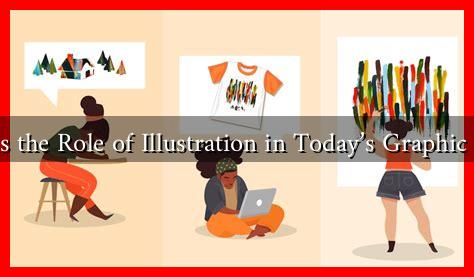-
Table of Contents
What Is the Role of Illustration in Today’s Graphic Design
In the ever-evolving world of graphic design, illustration has emerged as a powerful tool that enhances visual communication. As brands strive to differentiate themselves in a crowded marketplace, the role of illustration has become increasingly significant. This article explores the multifaceted role of illustration in contemporary graphic design, highlighting its importance, applications, and the impact it has on audience engagement.
The Importance of Illustration in Graphic Design
Illustration serves as a bridge between creativity and communication. It allows designers to convey complex ideas in a visually appealing manner. Here are some key reasons why illustration is vital in graphic design:
- Visual Storytelling: Illustrations can tell a story that resonates with the audience. They evoke emotions and create a narrative that can be more engaging than text alone.
- Brand Identity: Unique illustrations can help establish a brand’s identity. Companies like Mailchimp and Dropbox use custom illustrations to create a distinctive visual language that sets them apart.
- Versatility: Illustrations can be adapted for various mediums, from print to digital, making them a versatile choice for designers.
- Enhanced Engagement: Studies show that visual content is more likely to be shared on social media. According to a report by HubSpot, content with relevant images gets 94% more views than content without images.
Applications of Illustration in Graphic Design
Illustration finds its application across various domains within graphic design. Here are some notable areas where illustration plays a crucial role:
- Marketing Materials: Brochures, flyers, and posters often incorporate illustrations to grab attention and convey messages effectively.
- Web Design: Websites utilize illustrations to enhance user experience, making navigation intuitive and visually appealing. For instance, the website for the online learning platform Skillshare features vibrant illustrations that guide users through its offerings.
- Social Media: Brands leverage illustrations for social media campaigns to create eye-catching posts that stand out in crowded feeds.
- Editorial Design: Magazines and online publications use illustrations to complement articles, providing visual breaks and enhancing storytelling.
Case Studies: Successful Use of Illustration
Several brands have successfully integrated illustration into their graphic design strategies, resulting in increased engagement and brand loyalty. Here are a few examples:
- Dropbox: The cloud storage service uses playful illustrations to simplify complex concepts, making their service more approachable and user-friendly.
- Mailchimp: Known for its quirky and colorful illustrations, Mailchimp has created a unique brand identity that resonates with its target audience, making it memorable and relatable.
- Slack: The communication platform employs illustrations in its onboarding process, helping new users understand features through engaging visuals.
The Future of Illustration in Graphic Design
As technology advances, the role of illustration in graphic design is likely to evolve further. Here are some trends to watch:
- Augmented Reality (AR): AR technology is opening new avenues for interactive illustrations, allowing users to engage with content in immersive ways.
- Personalization: Custom illustrations tailored to individual user preferences are becoming more common, enhancing user experience and engagement.
- Sustainability: As brands focus on sustainability, illustrations that convey eco-friendly messages are gaining traction, helping to communicate values effectively.
Conclusion
Illustration plays a pivotal role in today’s graphic design landscape, serving as a powerful tool for visual storytelling, brand identity, and audience engagement. As brands continue to seek innovative ways to connect with their audiences, the importance of illustration will only grow. By leveraging the unique capabilities of illustration, designers can create compelling visuals that not only capture attention but also foster deeper connections with their audience. As we look to the future, embracing new technologies and trends will ensure that illustration remains a vital component of graphic design.
For more insights on graphic design and illustration, you can explore resources like Smashing Magazine and Creative Bloq.


